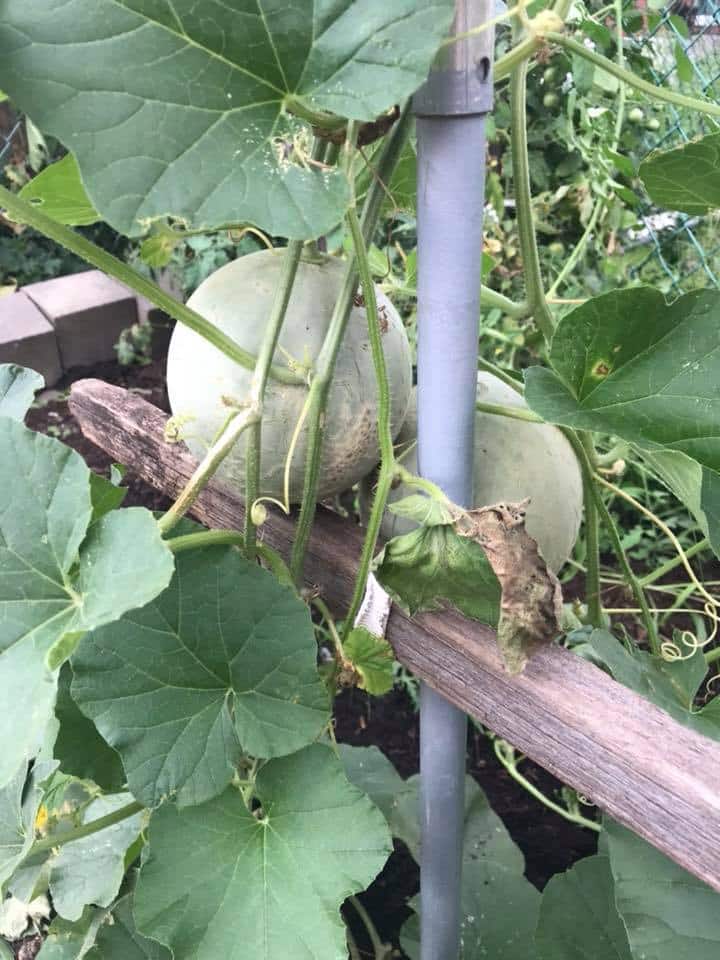Growing Honeydew is a task left for the wake of spring, with their fruits harvested in mid-summer. After sowing, the warm spring tide nourishes their seeds and the resulting seedlings!
If you sow the Honeydew seeds in mid-March, you can reap the fruits in mid-June. So, go through this entire article to learn about growing Honeydews.
Table of Contents Show
What Does a Honeydew Plant Look Like?
Honeydews belong to the Cucubitaceae family, alongside summer melons like Cantaloupes, Cucumbers, and Pumpkins.
Honeydew melon leaves resemble other Cucurbit varieties, attaining a heart-shaped outline with serrated margins and hairy surfaces.
Each vine can reach about 10 feet long while the plant statures at just 2 feet.
This happens during spring and summer when the sun is shining brightest and is the best time for growing Honeydew melons.
What Do Honeydew Seeds Look Like?
Honeydews have long growing seasons, from early spring to early fall, but are ready for harvest in mid-summer.
Look briefly at the table to learn more features of Honeydew seeds.
| Seed Metrics | Characteristics |
|---|---|
| Shape | Oval to Oblong |
| Length and Width | Length: About 7 mm Width: About 3 mm |
| Color | Green when freshly harvested Yellow-brown when dried |
| Weight | 0.043 to 0.052 gram |
| Germination Time | 7 to 14 days |
| Sowing Season | Spring |
| Sowing Depth | 0.5 to 1.5 inches |
| Germination Initiator | Temperature |
| Germination Temperature | Around 18 degrees Celsius |
| Soil Type For Germination | Moist and well-draining |
| Fruit Harvesting Period | About 75 to 120 days after germination |
| Fruit Harvesting Season | From mid-summer to early fall |
When to Plant Honeydew Seeds?
It takes 65-100 days to grow a Honeydew melon from seed.
Once pollination is completed, a small bulb at the bloom’s base transforms into a ripe melon within 30-45 days.
Afterward, crack open the fruits to harvest the seeds, scoop them out with a spoon, and place them for air-drying.
Air-dried seeds of Honeydews remain viable up to 4 years after the harvest.
If the seeds are fresh, you can directly sow them in spring.

However, starting seeds indoors about 3-6 weeks before the last frost is better if you live in cold areas.
Besides, each Honeydew plant can produce 2-6 melons. Thus, you will have enough seeds to propagate Honeydews in the next growing season.
Growing Honeydew Melons from Seeds
Seeds are the best way to start Honeydew if no seedlings are available.
For growing Honeydew melons in pots, sow their seeds indoors or plant them outdoors in the garden soil during early spring.
- Take seed starting mix and fill them in biodegradable pots about 3.5 inches wide.
- Plant 2-3 seeds per pot about 1-1.5 inches deep and 2 inches apart into moist soil.
If you direct-seed in the garden soil, select a sunny site, and plant the seeds 3 inches apart in groups of 3-4 seeds.
- Place a heating mat below the pots set at a temperature of 18°C. Seedlings shall emerge within 7-14 days.
- After the seedlings grow a set of true leaves, move them to a sunny window.
- You can also grow the seedlings beneath fluorescent grow lights for 16 hours daily, but give them a dark photoperiod for 8 hours.
- Once the seedlings are 3-4 weeks old, transfer them to a larger pot at least 18-24 inches wide.
- Fertilize them with half-strength of complete indoor houseplant food during this time.

Since Honeydews are climbers, you can move them to a single pot after their vines reach about 6 inches long.
Before transplanting the seedlings outdoors, harden them by moving the potted plants in the shade outdoors for a week.
Furthermore, protect them from heavy frost by moving the plants outside in the morning and indoors at night, or cover them by using a frost blanket.
This hardening process prevents transplant shock when you move the plantlets into the garden soil.
Moreover, if the plantlets are ready to grow in the garden soil, set up a trellis for the vines to climb.
But growing Honeydew on a trellis demands space, so plant them at a distance of 3-4 feet.
Here’s a quick instructive video about growing Honeydew melons on a trellis!
Care for Honeydews After Planting
The following tips will be helpful while caring for Honeydews after planting.
- Keep weeds under control by regularly removing them or using mulch to suppress their growth.
- Use a moisture meter to verify if the plant is under a dry spell and prevent waterlogging issues.
- Employ drips to deliver adequate water directly into the plant’s roots.
- Tie the delicate vines gently to the trellis scaffold, and don’t disturb them until they firmly attach themselves to the support.

- Support the ripe fruits in a mesh bag tied to the trellis to prevent them from falling.
- Place the ripe melons on a wooden plank to prevent pest or insect attacks.
- Use sterilized pruners to harvest the ripe melons by cutting the vines.
- Sustain the relative humidity levels of 65-75%. Flowering, fruiting, and foliage development of the plant occur between these levels.
- Fend off insect damage by avoiding companionship with same-family crops such as squash, pumpkins, or cucumbers.
- Keep fungal diseases in check by using fungicides such as myclobutanil.
Apply fungicide once a season if there is no disease but you need to spray it up to 6 times per season if there is frequent outbreaks.
From Editorial Team
Ripening the Honeydew fruits off-vine
To ripen the Honeydew off-vine, place the fruits in a perforated carrier, contain them in a plastic bag to preserve the odor, and refrigerate them.
